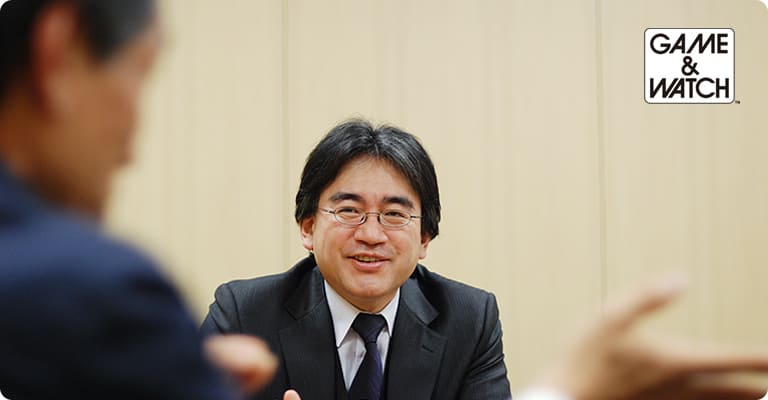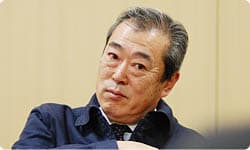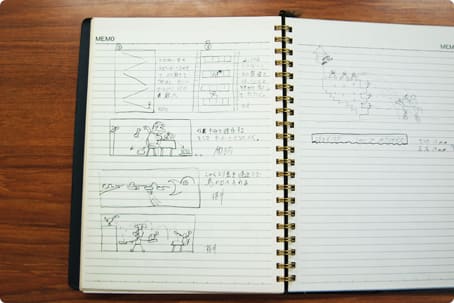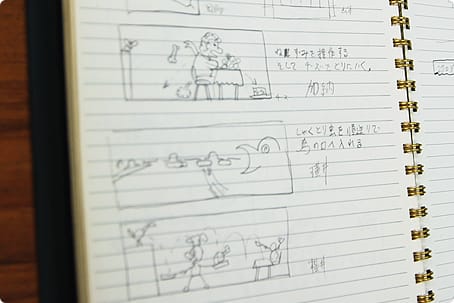Using a Calculator Chip
So you approached the Game & Watch system after having worked in a number of different capacities. The first title to come out was Game & Watch: Ball6, in 1980.
Yes. 6. Game & Watch: Ball: The first title in the Game & Watch series. The character in the center had to toss up and catch balls as they fell. Released in April 1980.
This is a bit of a digression, but by chance, 1980 is when HAL Laboratory7 was founded.
So it's been around 30 years now.
Yes. As 2010 approaches, I keep thinking how it's been 30 years.
We were in our twenties then.
I was still a university student. (laughs)
Oh? (laughs)
Yes. I started university in 1978, the year Yamamoto-san entered Nintendo. That was when Space Invaders8 hit it big.
That's right.
7. HAL Laboratory, Inc.: A software developer that has worked on the Kirby™ and Super Smash Bros.™ series, among others. When the company was founded, Iwata-san had a part-time job there. Later, he served the company as president.
8. Space Invaders: An arcade game released in 1978 by Taito Corporation.
I started high school in 1975, the year Izushi-san joined. When Kano-san joined in 1972, it was the year of the Sapporo Olympics and I was a sixth grader living in Sapporo!
Wow! (laughs)
A strange fate drew you, my predecessors, toward making Game & Watch.
By the way, I heard that (Gunpei) Yokoi-san9 hit on the idea for Game & Watch when he saw someone playing with a calculator on the Shinkansen. What did he say to you when development of Game & Watch began?
Unfortunately, I don't know much about that. I didn't get called from the Creative Section to Research & Development 1 and begin working on Game & Watch until the first title, Game & Watch: Ball, was already underway. At that point, Yokoi-san and (Satoru) Okada-san8 were already making the prototype.
9. Gunpei Yokoi (1941-1997): While at Nintendo, he was head of the Research and Development Department, and later of Research & Development 1. As a developer, he helped create the Game & Watch handheld electronic games, the Game Boy™ handheld system, R.O.B. (Robotic Operating Buddy), and the Dr. Mario™ game.
10. Satoru Okada: He worked on the Game Boy and Nintendo DS™ series. Formerly the General Manager, Research and Engineering Department.
You came in partway through, so you don't know what happened at the start.
No. But I do think it's true that Yokoi-san was inspired by calculators.
The chip used in Game & Watch was the same as in calculators. A single number on a calculator display is composed of seven segments, so…
Each number from 0 to 9 is made of seven parts called segments. In other words, it's a way to display numbers using seven component parts.
Right. So if a chip can calculate eight digits, that's 7 segments times 8 digits for a total of 56 segments. And there's the decimal point and symbols like the minus sign. We made the Game & Watch: Ball game using a chip that could display 72 segments.
You could turn each of those 72 segments on or off, and used them to represent objects rather than numbers.
Exactly.
And in the upper right-hand corner of the screen for Game & Watch: Ball was a four digit counter for points and time. There, we used 28 segments—or 7 segments by 4 digits.
You could use a total of 72 segments, so that left 44.
Right. We used the remaining segments to display the character and balls.
I see. I've also heard that you didn't decide to display time with the four-digit counter until the end of development.
I joined the project partway through, so I don't know how the clock function came about, but to display time digitally, you need a colon between the hour and minutes. Since that isn't there, I would guess it came along as an afterthought.
Using a crystal oscillator11 to add a clock function was easy. 11. Crystal oscillator: An electronic circuit element that resonates at a highly precise frequency. It is used for an accurate reference signal in clocks and computers.
The colon would use one segment, so maybe they just wanted to cut back there.
It could be used for the game instead.
Yeah, we didn't want to waste it! (laughs) Starting with the second title, Game & Watch: Flagman12, the thousands place was just a 1, and from with the sixth title, Game & Watch: Manhole12, "AM" and "PM" could be displayed.
12. Game & Watch: Flagman: The second title in the Game & Watch series. A flagman showed random numbers on flags and his feet and players had to press corresponding numbers in the same order. Released in June 1980.
13. Game & Watch: Manhole: The first title in the Game & Watch Gold Series (which had an alarm). Players had to move the location of a manhole cover so passersby wouldn't fall down manholes. Released in January 1981.
It could only display "1"?
Well, if you display "AM" and "PM"—like "PM 10:00"—then you can cut the number of segments used for four digits to below 28.
Uh-huh.
If you only display a "1" in the thousands place…
I see. "AM," "PM" and "1" make three segments. Numbers usually use seven, so you save four segments. (laughs)
Right. We wanted to use those four segments for gameplay. So the highest the counter could go was 1999.
(laughs)
We cut back where we could and used all the available segments.
Not a single segment went to waste.
Thinking up all kinds of ideas for dealing with such constraints was lots of fun. We had to figure out how to make a game with just a few available pieces.
Yeah, that was a lot of fun.
When you're under constraints is when ideas pop up.
That's right, they did.
It isn't necessarily a good thing to have absolute freedom when you make something new. Limits help you think of various things. Over the course of six years, the Game & Watch series sold 59 titles domestically and overseas. How did you come up with so many ideas?
Everyone from hardware developers to the planners and designers came up with ideas. Most of the games are based on everyday themes, so anyone could come up with them.
Everyone came up with ideas and we wrote them on a whiteboard.
A whiteboard?
Was it a blackboard? (laughs)
There weren't any whiteboards back then. (laughs)
(laughs)
And here (pulling out an old notebook) are some notes from one of those meetings.
Wow! What a valuable document! This is Game & Watch:Chef!14 14. Game & Watch: Chef: The fourth Game & Watch in the Wide Screen series. A chef must continually keep food in the air by flipping it up with his frying pan. Released in September 1981.
I'm amazed you still have these notes!
I hold on to everything. (laughs)
Are these your notes, Yamamoto-san?
Yes. I wrote down the ideas that came up at the meeting. Everyone exchanged ideas. But Yokoi-san made the final decision. (laughs)
With everyone brainstorming, the ideas would evolve and the games would grow increasingly complicated. Yokoi-san would pare away the unnecessary parts, focus on the core element of what was fun, and emphasize the product's appeal.
That's how it was, however frustrating it may have been sometimes! (laughs)





